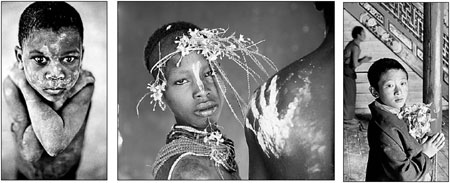Sharp eye for the human soul
Updated: 2013-12-08 08:15
By Mariella Radaelli (China Daily)
|
|||||||||||
Celebrated photographer Steve McCurry has a new book out and will be returning to China soon. Mariella Radaelli reports in Italy.
Steve McCurry's photographs have become modern icons. Eloquent, riveting and beautiful, their poetry penetrates to the very heart of the subject.
The great documentary photographer from the United States has a new book out, Steve McCurry Untold: The Stories Behind the Photographs.
The volume features the best of McCurry's photo stories taken around the world, from a portfolio spanning 30 years. Many of the photos are presented here for the first time.
"It is a tribute to the places I've been, the things I've seen and the people I've known," says the legendary photographer.
The book was published internationally in September, including a Chinese version by China Photographic Publishing House.
McCurry's stunning photos are currently on show at the Santa Maria della Scala museum in Siena, Italy. His work, which has achieved a compelling expressive intensity, has been displayed to the public in almost every corner of the world. China still awaits.
I met him in Milan, at a hotel along the Navigli canals. Shy, passionate and reflective, McCurry presented as an accomplished and insightful artist.
The conversation shifted from his fascination with Asia to his interest in Buddhism. He especially spoke about his enchantment with China and Africa.
"I find the regions of Asia so visually rich," he says.
Born in Philadelphia in 1950, he studied cinematography and theater at Penn State University. When and why did he decide to make photography his career?
"I was 22. Photography was the kind of work that I wanted to do," he says, recalling the exact moment he made that decision.
"I was walking around on a street in Philadelphia, and photographing life and kind of relaxing, kind of meditating and doing something I thought was pleasurable ... photographing some bicycles, children and side-walkers."
He launched his international career in 1978.
"The year I quit my job as a staff photographer at a newspaper in my hometown, Philadelphia, to buy a couple of hundred rolls of film and a one-way plane ticket to India."
A member of Magnum Photos, he is a regular contributor to many international journals, including National Geographic, whose June 1985 issue was graced by McCurry's iconic cover shot, Afghan girl, the portrait of young Sharbat Gula taken in a refugee camp in Pakistan.
As well as covering war zones - Afghanistan, Kuwait, Ethiopia - McCurry has also traveled 85 times to India. He has been on shoots several times in China as well. His insightful work across Southeast Asia earned him the famous Robert Capa Medal Award.
McCurry recalls his first trip to China in 1984.
"The political system was different. The people dressed the same; there was a kind of uniformity. We arrived at the train station and had to carry our heavy bags ... Everything was very simple then."
McCurry returned to a very different China in 1989, 1999, 2001 and 2006 and says he will travel to China again in a few months.
"There are so many authentic, incredible regions in China that represent its varied traditions and sensibilities. So many exciting, interesting things are happening in China now: in cinema, architecture, music."
McCurry has always been impressed by the hospitality of the Chinese. "People are very welcoming. They treat foreigners with cordiality and generosity," he says.
More recently, he has developed a passion for Africa.
"It's a fascinating place," he says. "Next summer I will go back to Ethiopia, where I was this past August. And I'll return to Kenya as well. I want to explore Africa more and more."
The New York-based photographer travels nine months a year.
"My job is very pleasurable," he says. "I wouldn't do it if it wasn't fulfilling and didn't give meaning to my life. I cannot imagine what could be more interesting than traveling the world and seeing all its geography, cultures, landscapes and people."
McCurry infuses even the most tragic shot with beauty, and the composition with chromatic harmony.
His photographs of life in the Tibet autonomous region are like a haunting silent movie, and are considered to be one of his most iconic series.
"My first trip to the Tibet autonomous region featured a visit to Tashi Lhunpo monastery, on assignment for a book entitled A Day in the Life of China," he says. He has returned many times to the Himalayan plateau where he captured the day-to-day spiritual existence of the Tibetans. He photographed monks, pilgrims and children. In 1999, he shot pictures for a black-and-white work entitled The Path to Buddha: A Tibetan Pilgrimage, which was published in 2003.
McCurry also showed me a picture he had taken from the roof of his apartment following the September 11, 2001, terrorist attacks in New York. Just one image of his painful reportage that showed the incredible devastation at Ground Zero.
"Sometimes I have been in places of overriding beauty, sometimes in places I'd like to forget. But nothing has dented my faith in the human spirit or in unexpected human kindness," he says.
Contact the writer at sundayed@chinadaily.com.cn


(China Daily 12/08/2013 page4)
Today's Top News
Cameron answers questions on Weibo
Top legislature rejects JP resolution
Haze chokes China's east, north
S. African politics not affected
China film festival opens in London
Nations to jointly tap nuclear markets
Xi leads China's tributes to Mandela
Smog gives expats second thoughts
Hot Topics
Lunar probe , China growth forecasts, Emission rules get tougher, China seen through 'colored lens', International board,
Editor's Picks

|

|

|

|

|

|





